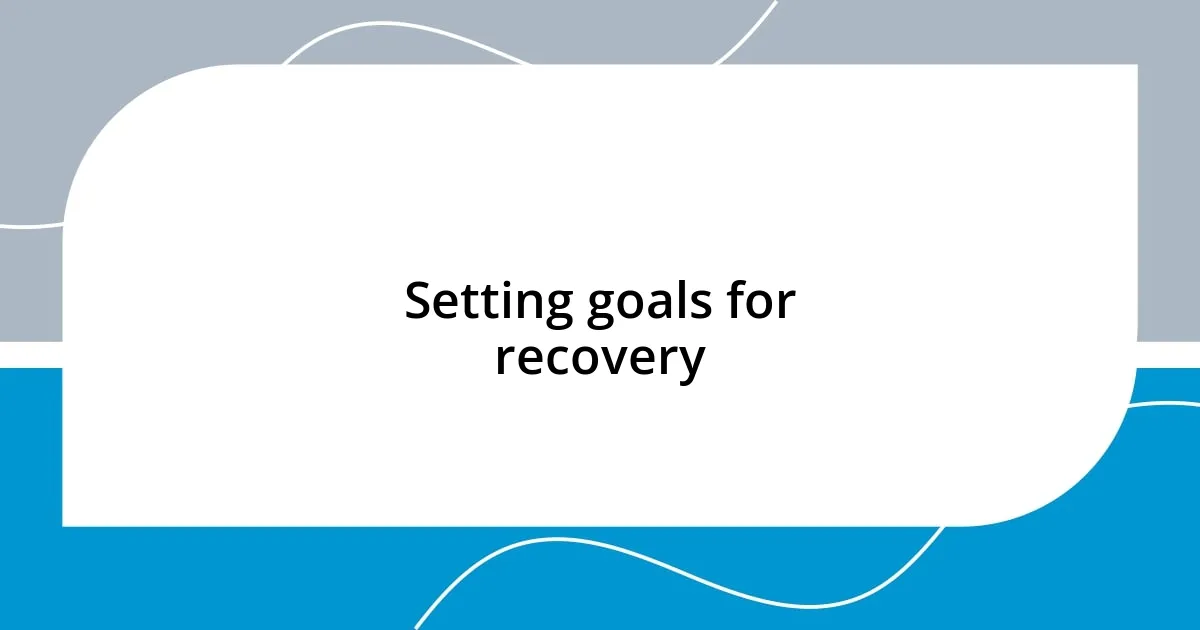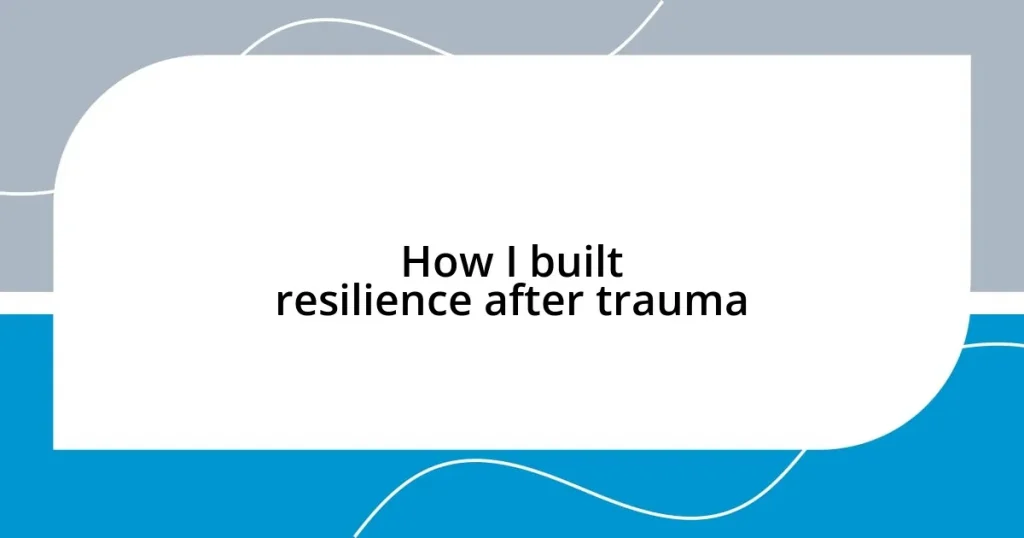Key takeaways:
- Trauma impacts daily life, but cultivating resilience involves recognizing personal responses and finding small joys.
- Identifying signs of distress is crucial for proactive self-care and emotional management.
- Building strong, supportive relationships enhances resilience and healing through shared experiences.
- Setting manageable recovery goals and celebrating small milestones empower continued personal growth.

Understanding trauma and resilience
Trauma can often feel like an uninvited guest that settles in and refuses to leave. Personally, I remember the lingering shadows in my life after a significant loss; those moments when even the simplest of tasks felt insurmountable. Isn’t it fascinating how trauma can have such a profound grip on our daily existence, often altering our perceptions of safety and happiness?
Resilience, on the other hand, is like the internal compass that helps navigate through the storm. I experienced this firsthand when I began to discover small joys in everyday life—things like a warm cup of coffee in the morning or a smile from a stranger. These moments may seem trivial, but in the wake of trauma, they became my lifelines, reminding me that happiness was still within reach. How does one cultivate such resilience in the face of adversity, I wondered, and it became clear to me that it starts with recognizing that our responses to trauma are deeply personal.
Understanding the interplay between trauma and resilience is crucial for healing. It’s not just about bouncing back but rather embracing our unique journeys and allowing ourselves to grow. Have you ever noticed how sharing your story can create a bond with others? For me, opening up about my experiences not only helped me process the pain but also revealed common threads of struggle and strength in those around me. It’s these connections that ultimately build resilience, transforming trauma into a foundation for renewed strength and hope.

Recognizing personal signs of distress
Recognizing when distress surfaces can be a transformative step in the journey of healing. I can recall the unsettling feelings that crept in unexpectedly—like when my heart would race over a minor inconvenience or when I found myself withdrawing from friends, feeling suffocated by invisible weights. These moments were signals, urging me to pay attention to my emotional landscape and prompting a deeper exploration of what was happening inside me.
Here are some personal signs of distress I learned to recognize:
- Rapid heartbeat or shallow breathing during mundane tasks.
- Persistent feelings of sadness or frustration that linger longer than usual.
- A desire to isolate myself, avoiding social interactions or even simple conversations.
- Heightened sensitivity to noise or chaos, making it hard to focus.
- Physical symptoms like headaches or fatigue without clear reasons.
By identifying these signs, I was able to take proactive steps toward self-care and address my emotional needs before they became overwhelming.

Strategies for building emotional strength
Building emotional strength after trauma is a deeply personal journey, and I’ve found that specific strategies can make a significant difference. One approach that worked wonders for me was practicing mindfulness. There were times when anxiety would bubble up, and I would simply take a moment to focus on my breath. In those instances, closing my eyes and appreciating the stillness around me helped ground me, allowing me to reframe my thoughts. It’s incredible how such small practices can create a ripple effect in our emotional well-being. Have you ever tried to pause and simply observe your surroundings? It’s a game changer!
Another effective strategy I’ve embraced is journaling. When I sat down with my thoughts, I often reacted with surprise at the number of emotions that flowed out. Writing allowed me to articulate feelings that I’d previously buried, encouraging me to confront them. The pages became not just a record of my journey, but a mirror reflecting my growth. I recommend setting aside a few minutes each day, even if it’s just to jot down a few sentences. How does it feel to put pen to paper and express your innermost thoughts?
Lastly, connection is vital. I’ve learned that leaning on supportive relationships can fortify emotional strength. Whether it’s sharing a meal with a friend or participating in a support group, these interactions bring perspective and remind me that I’m not alone in my struggles. During one particularly challenging week, a simple phone call with a close friend helped me navigate through murky waters. It really reinforced my belief that while personal healing is essential, the shared human experience enhances it.
| Strategy | Description |
|---|---|
| Mindfulness | Practicing mindfulness through breathing techniques can help ground your thoughts and emotions. |
| Journaling | Writing down your feelings can provide clarity and facilitate emotional expression. |
| Connection | Engaging with supportive relationships can bolster your emotional resilience. |

Establishing supportive relationships
Establishing strong, supportive relationships has been a cornerstone in my healing journey. I remember feeling utterly lost during one of my darkest days, and it was a simple message from a friend that broke through the fog. Just knowing someone was thinking of me made a world of difference. Have you experienced the power of a small gesture that brings light when you feel shrouded in shadows? That connection became a lifeline for me.
I also found that joining a community based on shared experiences proved invaluable. In a support group I attended, I met individuals who genuinely understood the weight of trauma. Opening up about our struggles not only fostered a sense of belonging but also helped me realize I wasn’t alone. It was empowering to hear others share their stories and resilience, prompting me to reflect on my own journey. Isn’t it interesting how sharing burdens can lighten their weight?
Of course, maintaining these relationships requires effort, and I’ve had my fair share of ups and downs. I cherish the moments of laughter with friends, but there have been times I hesitated to reach out when I needed support. Looking back, I’ve learned that vulnerability is not a sign of weakness; it’s an invitation to deepen connections. How would your life change if you embraced vulnerability? Establishing that bond with others reshaped my resilience, reminding me that healing is often a communal experience.

Practicing self-care techniques
Practicing self-care techniques has been transformative for me in reclaiming my emotional well-being. One technique I found particularly beneficial was engaging in regular physical activity. I remember those days when I’d step onto a yoga mat, and it felt like my worries melted away, replaced by a sense of peace and empowerment. Isn’t it amazing how movement can reset our mindset? Even a short walk outside could shift my perspective, allowing me to reconnect with my body and environment.
Another self-care approach that truly resonated with me is setting healthy boundaries. There was a point when I felt overwhelmed by the expectations of others, and learning to say “no” became a powerful act of self-love. I can recall a situation where I declined an invitation that would have drained my energy. In that moment, I felt a weight lift off my shoulders, reminding me that prioritizing my needs wasn’t selfish; it was necessary. Have you ever experienced the freedom that comes from honoring your own limits?
Finally, indulging in creative outlets has been a sanctuary for my soul. I often find that painting or even cooking allows me to express emotions I sometimes struggle to articulate. There was a time I picked up a paintbrush, and as colors danced on the canvas, I felt waves of emotions transforming into vibrant strokes. Isn’t it fascinating how creativity can provide an avenue for healing? Finding your own creative escape can be a delightful way to connect with yourself and navigate the complexities of your feelings.

Setting goals for recovery
Setting goals for recovery has been a pivotal part of my healing process. I vividly recall sitting down one evening, pen in hand, and feeling overwhelmed by the journey ahead. It was then that I realized how breaking down my recovery into smaller, manageable goals could turn that daunting path into a series of achievable steps. Have you ever experienced the clarity that comes from writing your thoughts down?
I remember one particular goal I set: to practice mindfulness for just ten minutes each day. At first, it felt uncomfortable and somewhat futile, but as days turned into weeks, I began to see its impact. That simple commitment became a sanctuary, a moment where I could breathe and step back from the chaos. Can you think of a small commitment that could transform your daily routine?
Furthermore, celebrating each milestone, no matter how small, became essential in my recovery. There was a moment I finished reading a book I had put off for ages, and I felt a rush of accomplishment. It was a reminder that every step, even when the progress seemed minuscule, contributes to a greater journey. Isn’t it rewarding to acknowledge our successes, even the quiet ones? By setting these goals and celebrating them, we not only recognize our growth but also empower ourselves to keep moving forward.
















